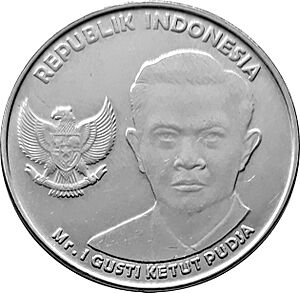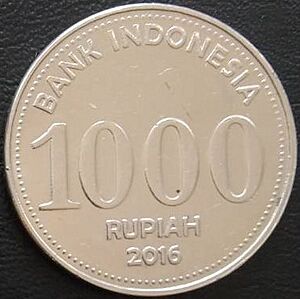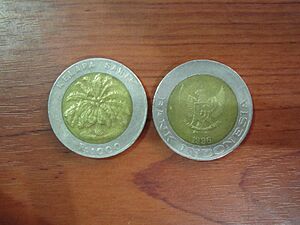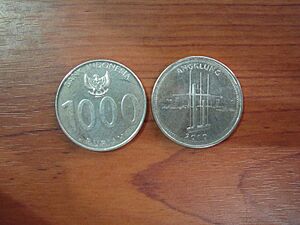Indonesian 1,000-rupiah coin facts for kids
| Indonesia | |
| Value | Rp 1,000 |
|---|---|
| Mass | 4.5 g |
| Diameter | 24.1 mm |
| Thickness | 1.6 mm |
| Edge | Smooth |
| Composition | Nickel-plated steel |
| Years of minting | 1993–present (updated 2010, 2016) |
| Obverse | |
 |
|
| Designer | Bank of Indonesia |
| Design date | 2016 |
| Reverse | |
 |
|
| Designer | Bank of Indonesia |
| Design date | 2016 |
The Indonesian one thousand rupiah coin (also called Rp1,000) is a coin used in Indonesia. It's worth 1,000 rupiah and is used alongside a 1,000-rupiah paper money. These coins first came out on March 8, 1993. Back then, they were made of two different metals, which is called bimetallic.
Later, in 2010, new Rp1,000 coins were made from just one type of metal, called unimetallic. The newest design for this coin came out in 2016. As of 2024, the coins from 2010 and 2016 are still valid to use for buying things.
Contents
First Rp1,000 Coin (1993-2000)
This was the very first Rp1,000 coin. It was a bimetallic coin, meaning it had two parts. The outer ring was made of cupronickel, and the inner circle was made of an aluminum-nickel-bronze mix.
This coin weighed about 8.6 g (0.30 oz). It was 26 mm (1.0 in) wide and 2.2 mm (0.087 in) thick. The edge of the coin had a jagged pattern.
The front side of the coin showed the national symbol of Indonesia, called Garuda Pancasila. The year the coin was made was also on the inner circle. The words "BANK INDONESIA" were on the outer ring. The back side featured an oil palm tree in the middle. Around it were the words "KELAPA SAWIT" (which means oil palm) and "Rp1000." These coins were made in the years 1993, 1994, 1995, 1996, 1997, and 2000.
Some people online tried to sell these coins for very high prices, sometimes up to Rp100 million. But in reality, these coins are usually sold for much less, around Rp3,000 to Rp10,000. Even the best quality coins are only worth up to Rp4,000,000. These coins were officially stopped from being used on December 1, 2023. However, you can still exchange them at banks until December 1, 2033.
Second Rp1,000 Coin (2010)
The Rp1,000 coin was made again in 2010, but this time it was a unimetallic coin. This means it was made from just one metal: nickel-plated steel. The new coin was announced on July 20, 2010.
The front of this coin showed the national symbol Garuda Pancasila and the words "1000 RUPIAH." The back side featured the angklung, a musical instrument from West Java. It also showed the Gedung Sate, a famous building in Bandung, the capital city of West Java. The words "ANGKLUNG" and "2010" were also on the back.
This coin is 24.15 mm (0.951 in) wide and 1.6 mm (0.063 in) thick. It weighs 4.5 g (0.16 oz) and has a smooth edge.
Third Rp1,000 Coin (2016)
The Rp1,000 coins were given a new look on December 19, 2016. The front of this coin now features the national hero I Gusti Ketut Puja. It also shows the national symbol Garuda Pancasila and the words "REPUBLIK INDONESIA."
The back of the coin has the words "BANK INDONESIA," "1000 RUPIAH," and "2016." There are also circle patterns around the inner edge of the coin. These coins are made of nickel-plated steel. They weigh 4.5 g (0.16 oz), are 24.1 mm (0.95 in) wide, and are 1.45 mm (0.057 in) thick. Like the 2010 coin, they have a smooth edge.
Special Commemorative Coin (1970)
Besides the coins used every day, the Bank of Indonesia also made a special Rp1,000 coin in 1970. This coin was made of silver and was not meant for everyday use. It was created to celebrate Indonesia's 25th year of independence.
This special coin weighed 40 g (1.4 oz) and was 55 mm (2.2 in) wide. Its edge had a reeded pattern (small ridges). The front of the coin showed the national symbol Garuda Pancasila, the Bank of Indonesia's logo, and the years "1945-1970." It also had "1000 RUPIAH" and the year it was made (1970). The back of the coin featured a picture of General Sudirman. It also had the words "25 TAHUN KEMERDEKAAN" (25 Years of Independence) and "REPUBLIK INDONESIA."
See also
- Indonesian rupiah
- Coins of the rupiah



